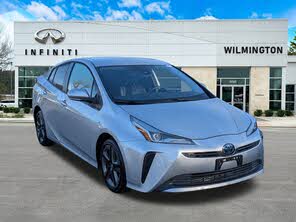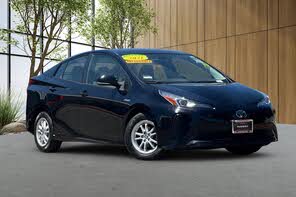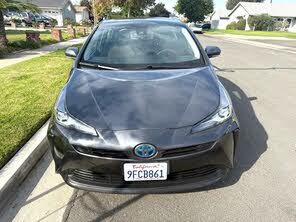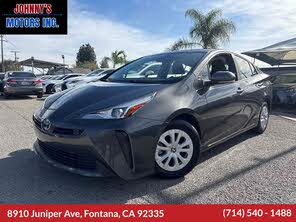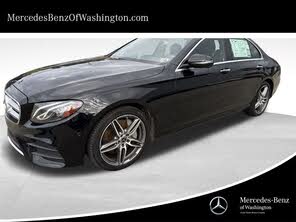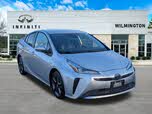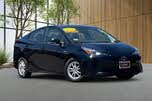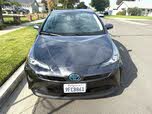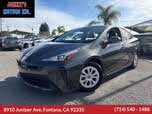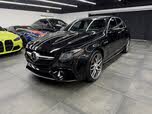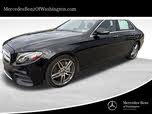2021 Toyota Prius vs 2020 Mercedes-Benz E-Class
Overview | |
MSRP$54,050 | MSRP$24,525 |
Listings260 | Listings152 |
Ratings & Reviews | |
User Reviews | User Reviews |
Expert reviews8.0 out of 10 | Expert reviews6.2 out of 10 |
Pros
Cons
| Pros
Cons
|
2020 Mercedes-Benz E-Class Reviews SummaryA Mercedes-Benz is a physical indulgence that gives as much or as little pleasure as your checking account allows. The 2020 E-Class starts off well-equipped in ways a $55,000 Mercedes wasn't just a few years ago, and it becomes decadent and power-drunk once you start adding options. For 2020, a new base engine joins this car's stellar design, technology, and effortless demeanor. | |
2021 Toyota Prius Reviews SummaryTo many people, cars are appliances made to serve a function. These consumers own a car because they need to get from where they are to where they’re going, and with a minimum of hassle, expense, or discomfort. Reliability, efficiency, safety, and economy are the critical deciding factors, and the 2021 Toyota Prius delivers on all fronts. Confusingly, for 2021, the Prius lineup offered a 2020 Edition. Toyota built just 2,020 examples to commemorate the 20th anniversary of the first Prius sold in the U.S. market. It has blacked-out trim, black 17-inch wheels, a body-color rear spoiler, and comes in Supersonic Red or new Wind Chill paint colors. Additionally, Toyota improved the 2021 Prius’s driving-assistance systems by making Toyota Safety Sense 2.0 standard across the board. Android Auto is also standard (joining Apple CarPlay), except for the unique infotainment system in the Prius Limited. | |
No video found | |
Popular Features & Specs | |
Engine2.0L 255 hp I4 | Engine1.8L 121 hp I4 Hybrid |
Drive TrainRWD | Drive TrainFWD |
Seating Capacity5 | Seating Capacity5 |
Horsepower255 hp @ 5800 rpm | Horsepower |
EV Battery Capacity | EV Battery Capacity0.7 kWh |
MPG City23 | MPG City58 |
MPG Highway32 | MPG Highway53 |
Engine | |
Engine Name2.0L 255 hp I4 | Engine Name1.8L 121 hp I4 Hybrid |
Torque273 lb-ft @ 1800 rpm | Torque |
Horsepower255 hp @ 5800 rpm | Horsepower |
DrivetrainRWD | DrivetrainFWD |
Fuel Economy | |
EV Battery Capacity | EV Battery Capacity0.7 kWh |
MPG City23 | MPG City58 |
MPG Highway32 | MPG Highway53 |
Interior | |
Seating Capacity5 | Seating Capacity5 |
Key Features | |
Navigation SystemStandard | Navigation System |
Sunroof/MoonroofStandard | Sunroof/Moonroof |
Safety | |
Front Crash Overall5 | Front Crash Overall4 |
Side Crash Overall5 | Side Crash Overall5 |
Dimensions & Capacity | |
Cargo Space13.1 cu ft | Cargo Space27.4 cu ft |
Curb Weight3814 lbs | Curb Weight3010 lbs |
Height57.8 in | Height57.9 in |
Length193.8 in | Length180.0 in |
Width81.3 in | Width69.3 in |
Wheelbase115.7 in | Wheelbase106.3 in |
Maximum Payload | Maximum Payload825 lbs |
Number of doors4 | Number of doors4 |
Overview | ||
MSRP | $54,050 | $24,525 |
Listings | ||
Ratings & Reviews | ||
User reviews | ||
Expert reviews | 8.0 out of 10Read full review | 6.2 out of 10Read full review |
Pros & cons | Pros
Cons
| Pros
Cons
|
Summary | A Mercedes-Benz is a physical indulgence that gives as much or as little pleasure as your checking account allows. The 2020 E-Class starts off well-equipped in ways a $55,000 Mercedes wasn't just a few years ago, and it becomes decadent and power-drunk once you start adding options. For 2020, a new base engine joins this car's stellar design, technology, and effortless demeanor. | To many people, cars are appliances made to serve a function. These consumers own a car because they need to get from where they are to where they’re going, and with a minimum of hassle, expense, or discomfort. Reliability, efficiency, safety, and economy are the critical deciding factors, and the 2021 Toyota Prius delivers on all fronts. Confusingly, for 2021, the Prius lineup offered a 2020 Edition. Toyota built just 2,020 examples to commemorate the 20th anniversary of the first Prius sold in the U.S. market. It has blacked-out trim, black 17-inch wheels, a body-color rear spoiler, and comes in Supersonic Red or new Wind Chill paint colors. Additionally, Toyota improved the 2021 Prius’s driving-assistance systems by making Toyota Safety Sense 2.0 standard across the board. Android Auto is also standard (joining Apple CarPlay), except for the unique infotainment system in the Prius Limited. |
Video | No video found | |
Popular Features & Specs | ||
Engine | 2.0L 255 hp I4 | 1.8L 121 hp I4 Hybrid |
Drive Train | RWD | FWD |
Seating Capacity | 5 | 5 |
Horsepower | 255 hp @ 5800 rpm | |
EV Battery Capacity | 0.7 kWh | |
MPG City | 23 | 58 |
MPG Highway | 32 | 53 |
Engine | ||
Engine Name | 2.0L 255 hp I4 | 1.8L 121 hp I4 Hybrid |
Torque | 273 lb-ft @ 1800 rpm | |
Horsepower | 255 hp @ 5800 rpm | |
Drivetrain | RWD | FWD |
Fuel Economy | ||
EV Battery Capacity | 0.7 kWh | |
MPG City | 23 | 58 |
MPG Highway | 32 | 53 |
Interior | ||
Seating Capacity | 5 | 5 |
Key Features | ||
Navigation System | Standard | |
Sunroof/Moonroof | Standard | |
Safety | ||
Front Crash Overall | 5 | 4 |
Side Crash Overall | 5 | 5 |
Dimensions & Capacity | ||
Cargo Space | 13.1 cu ft | 27.4 cu ft |
Curb Weight | 3814 lbs | 3010 lbs |
Height | 57.8 in | 57.9 in |
Length | 193.8 in | 180.0 in |
Width | 81.3 in | 69.3 in |
Wheelbase | 115.7 in | 106.3 in |
Maximum Payload | 825 lbs | |
Number of doors | 4 | 4 |
The 2020 Mercedes-Benz E-Class, reminiscent of its predecessors, boasted a smooth, rounded body that aligned with the brand's traditional design language. Despite its streamlined appearance, which some critics felt could use a few more edges, it maintained a familial resemblance to the larger S-Class and smaller C-Class. This model was available in various forms, including sedan, wagon, coupe, and cabriolet, catering to a conservative clientele. The sedan, in particular, exuded luxury with its classic hood ornament and chrome grille, while most models featured a sportier grille with a prominent Mercedes emblem. The E-Class's LED lighting added a touch of elegance, and its proportions were visually appealing across different configurations, from the Luxury model's higher suspension to the sportier versions with larger wheels and quad exhausts.
Inside, the E-Class cabriolet stood out with its contrasting soft top and luxurious interior. The cabin, when specified with multi-tone leathers and polished wood, offered a sumptuous experience. The expansive digital screens, spanning two feet across the dashboard, provided a high-tech feel, complemented by industrial elements like circular air vents and silver toggles. The ambient lighting, available in 64 colors, added to the car's serene atmosphere. Even the base model, with its leatherette upholstery, felt superior to many competitors, offering features like heated armrests and massaging seats for a truly comfortable ride.
The 2021 Toyota Prius retained its iconic boomerang-shaped design, a hallmark since its second generation. While the styling was no longer necessary for aerodynamic efficiency, it remained a defining feature of the Prius's identity. However, the design was not universally praised, even in the trendy 2020 Edition with blacked-out trim. Inside, the Prius featured a unique layout with a central strip of displays near the windshield and unconventional transmission controls. The dashboard's dramatic wrap into the door panels and the narrow center console added to the car's quirky interior design. Gloss-black trim, while stylish, was prone to attracting dust and fingerprints.
The Prius was available in several trims, including L Eco, LE, XLE, 2020 Edition, and Limited, with an optional AWD-e system for the LE and XLE. The Prius Prime plug-in hybrid offered different styling and trim options. As a five-door hatchback, the Prius provided substantial utility akin to a crossover SUV, though without the rugged appearance or ground clearance. Prices ranged from $24,525 to $32,650, with the 2020 Edition test vehicle priced at $31,295, including destination charges.










The 2020 Mercedes-Benz E-Class offered a range of powertrains, starting with the E350, which replaced the E300. The E350 featured a turbocharged 2.0-liter 4-cylinder engine producing 255 horsepower and 273 pound-feet of torque, paired with a 9-speed automatic transmission. Despite its modest power increase, the E350 delivered improved responsiveness thanks to a revised turbo design. However, its performance above 40 mph was less impressive, and the car's weight made passing maneuvers challenging. For those seeking more power, the E450 with a 3.0-liter V6 engine offered 362 horsepower and 369 pound-feet of torque, providing a more balanced and effortless driving experience.
For performance enthusiasts, the AMG E53 and AMG E63 S models delivered exhilarating power. The AMG E53 featured a hybrid setup with a V6 engine, producing 429 horsepower and 384 pound-feet of torque, while the AMG E63 S boasted a 4.0-liter twin-turbo V8 with 603 horsepower and 627 pound-feet of torque. The E-Class offered various drivetrain options, including rear-wheel drive and all-wheel drive, with performance-tuned AWD available on AMG models. Fuel economy varied depending on the powertrain, with estimates ranging from 19 to 32 mpg.
In contrast, the 2021 Toyota Prius prioritized fuel efficiency over performance. The L Eco version achieved an impressive 56 mpg in combined driving, while other front-drive models earned 52 mpg, and AWD-e models managed 49 mpg. The Prius 2020 Edition averaged 47.5 mpg during testing. The Prius combined a 1.8-liter four-cylinder engine with a 53-kilowatt electric motor, producing a total of 121 horsepower. While not powerful, the electric motor's torque provided lively acceleration from a stop and allowed for electric-only driving at low speeds.
The Prius offered various driving modes, including EV Mode for electric-only driving, and Eco, Normal, and Power modes to optimize efficiency or responsiveness. The car's regenerative braking system helped recharge the battery during deceleration. The Prius's Toyota New Global Architecture (TNGA) platform contributed to its handling capabilities, providing a lower center of gravity and a more athletic feel. While not a performance car, the Prius handled curvy roads with enthusiasm, offering predictable handling and commendable braking feel.
The 2020 Mercedes-Benz E-Class featured a complex infotainment system called COMAND, which could be challenging to navigate on its large screens. The lack of touchscreens was a notable drawback, requiring multiple steps to adjust settings and input addresses. The system's complexity could be distracting, but the E-Class offered functional features like seat controls on the door panels and ample interior space. The coupe had a usable rear seat, and the wagon included a rear-facing jump seat for small children. The E-Class provided a comfortable and spacious interior with clear sightlines and high-resolution digital displays.
The 2021 Toyota Prius, often perceived as a small car, offered surprising interior space. It accommodated up to five passengers, with comfortable seats upholstered in Toyota's SofTex synthetic leather. The test vehicle featured an eight-way power driver's seat, heated front seats, and a heated steering wheel. However, the low seating position made entry and exit more challenging. The rear seats provided adequate room for adults, though they lacked air-conditioning vents. Cargo space varied by trim, with up to 27.4 cubic feet behind the rear seats and up to 50.7 cubic feet with the seats folded down.
The 2020 Mercedes-Benz E-Class boasted advanced technology, including a semi-automated driving system with features like lane-changing assistance and obstacle avoidance. The Driver Assistance Package offered a comprehensive suite of safety features. The E-Class also included a V2X system for communication with nearby Mercedes models, customizable digital displays, and standard connectivity options like Bluetooth, Apple CarPlay, and Android Auto. The Burmester stereo provided high-quality sound, and the car featured unique options like the Energizing Comfort Package for personalized comfort settings.
The 2021 Toyota Prius featured a 7-inch touchscreen infotainment system with standard connectivity options, including Bluetooth, SiriusXM, Apple CarPlay, and Android Auto. The Limited trim offered an upgraded 11.6-inch touchscreen with additional features like a JBL premium sound system and navigation. However, the sound quality was lacking, and road noise could overwhelm the audio experience. The digital instrumentation displayed dated graphics, and the overall technology package did not convey a sense of sophistication.
The 2020 Mercedes-Benz E-Class sedan and wagon received top safety ratings, including a 5-star overall rating from the NHTSA and a Top Safety Pick+ designation from the IIHS. The E-Class featured innovative safety technologies, such as Pre-Safe Sound and side bolster inflation during a side collision. Standard safety features included forward emergency braking and blind-spot monitoring, with additional driver-assist features available as options.
The 2021 Toyota Prius came equipped with Toyota Safety Sense 2.0, offering a comprehensive suite of safety systems, including adaptive cruise control, forward-collision warning, and lane-keeping assistance. The Prius LE and higher trims included blind-spot monitoring with rear cross-traffic alert. While the NHTSA did not rate the 2021 Prius, the IIHS provided favorable marks, though it did not achieve a Top Safety Pick designation.
CarGurus highlights

According to CarGurus experts, the overall rating for the 2020 Mercedes-Benz E-Class is 8.0 out of 10, while the 2021 Toyota Prius scores 6.2 out of 10. Based on these ratings, the 2020 Mercedes-Benz E-Class is the recommended choice for those seeking a luxurious and technologically advanced vehicle with strong safety credentials.
Choose the 2021 Toyota Prius if:
- You prioritize fuel efficiency and eco-friendly driving.
- You need a practical and spacious interior with ample cargo capacity.
- You seek a comprehensive suite of standard safety features.
Choose the 2020 Mercedes-Benz E-Class if:
- You prioritize luxury and advanced technology features.
- You desire a range of powerful engine options, including AMG performance models.
- You value top safety ratings and innovative safety technologies.
CarGurus highlights

According to CarGurus experts, the overall rating for the 2020 Mercedes-Benz E-Class is 8.0 out of 10, while the 2021 Toyota Prius scores 6.2 out of 10. Based on these ratings, the 2020 Mercedes-Benz E-Class is the recommended choice for those seeking a luxurious and technologically advanced vehicle with strong safety credentials.
Choose the 2021 Toyota Prius if:
Shop Now- You prioritize fuel efficiency and eco-friendly driving.
- You need a practical and spacious interior with ample cargo capacity.
- You seek a comprehensive suite of standard safety features.
Choose the 2020 Mercedes-Benz E-Class if:
Shop Now- You prioritize luxury and advanced technology features.
- You desire a range of powerful engine options, including AMG performance models.
- You value top safety ratings and innovative safety technologies.

By: CarGurus + AI
At CarGurus, our team of experienced automotive writers remain at the heart of our content operation, conducting hands-on car tests and writing insightful guides that are backed by years of industry experience. To complement this, we are harnessing AI to make our content offering more diverse and more helpful to shoppers than ever. To achieve this, our AI systems are based exclusively on CarGurus content, ratings and data, so that what we produce is both unique to CarGurus, and uniquely helpful to car shoppers.


